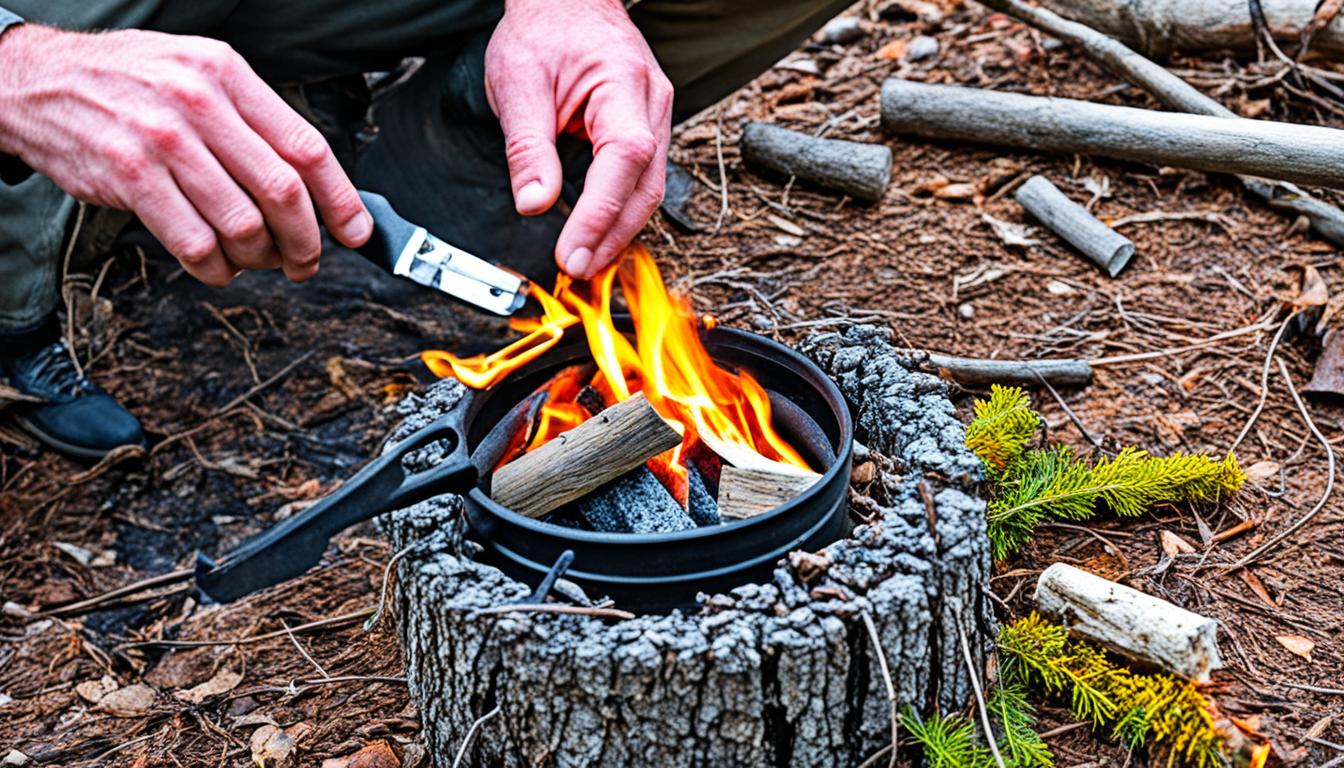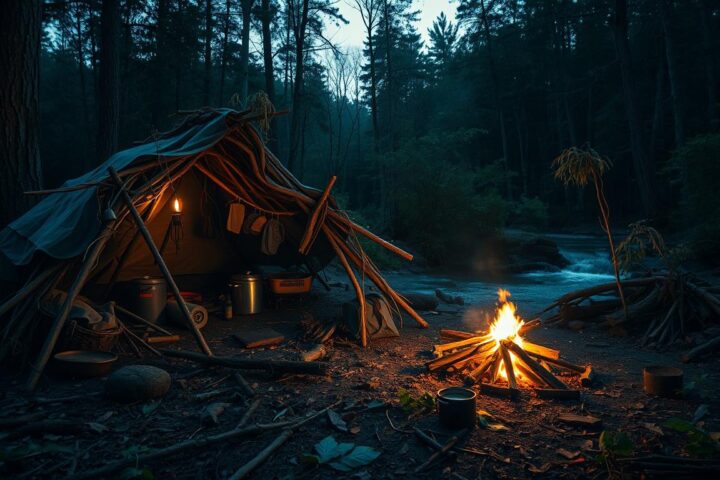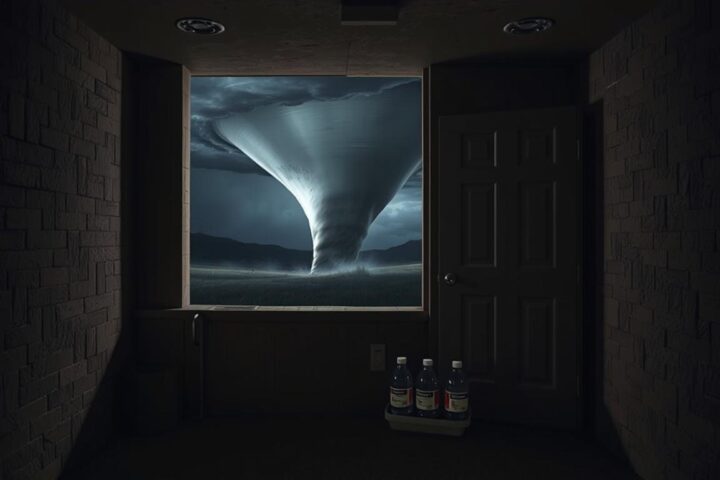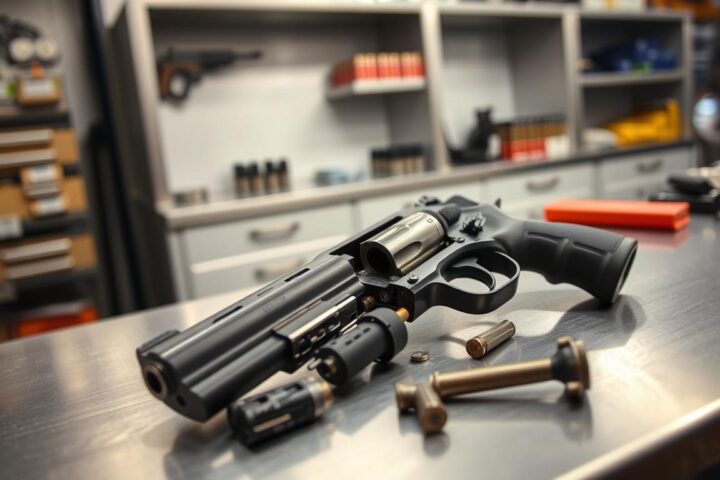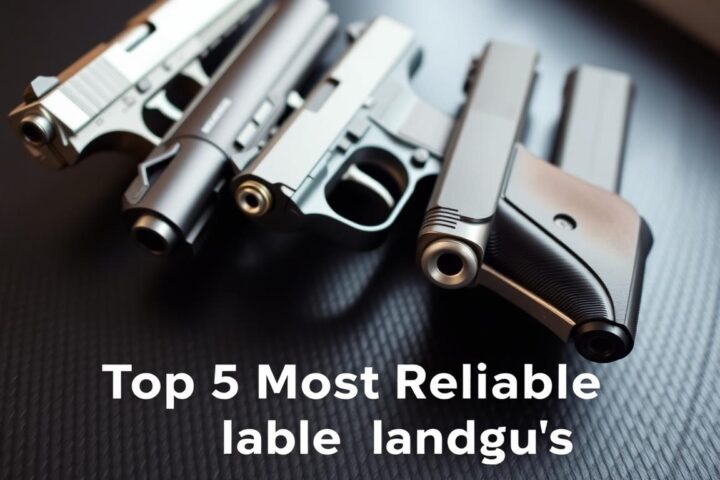Learning survival skills in your backyard is a safe and easy way to prepare for the wilderness. It’s a great way to get ready for any survival situation. Here are eight basic skills to learn and master:
- Building a fire
- Creating potable water
- Foraging for food
- Tying knots
- Making a weapon
- Building a shelter
- Administering basic first aid
- Fishing and trapping
These skills are crucial for anyone who loves the outdoors. The Takeaway is clear: you don’t have to wait until you’re in the wilderness to learn them. Practicing these essential survival skills in your backyard is a great weekend project.
Introduction to Survival Skills Training
Learning survival skills is not just for experts in the wilderness. It’s a skill set that can help anyone, especially kids. It builds confidence, boosts self-esteem, gets you moving, and connects you with nature. We’ll cover seven key skills for surviving in the wild.
These skills include making a survival kit, using a map and compass, building shelters, purifying water, and giving first aid. You can learn these in a local park, a campground, or even your backyard. The aim is to make learning fun and engaging. No need for wilderness experience – just a love for adventure and a desire to learn.
Wilderness survival training has many benefits. It prepares kids for emergencies and helps them appreciate nature. It teaches bushcraft techniques that humans have used for centuries. Whether you aim to increase your family’s self-reliance or just enjoy outdoor activities, these skills are invaluable.
Creating a Survival Kit for Kids
Getting kids ready for the outdoors means giving them the right tools and resources. One key step is teaching them to make their own survival kit. This kit is a must-have, packed with tools for staying safe in the wild.
It’s filled with skills like wilderness survival training and outdoor emergency preparedness. By making their own kit, kids learn essential bushcraft and safety skills.
A basic survival kit for kids should have these items:
- A small backpack or fanny pack to hold the supplies
- A reliable compass for finding your way off the beaten path
- Fire-starting tools like matches, lighters, or a first aid kit
- An emergency blanket for warmth and shelter
- A water filter or purification tablets for clean water
- Plastic storage bags to keep things dry
- A multi-tool or pocket knife for different tasks
- A flashlight or headlamp for seeing in the dark
- Space for a first aid kit for minor injuries and illnesses
Teaching kids about their survival kits is key to outdoor readiness. Knowing what each item does helps them tackle unexpected challenges. They’ll be ready for anything the wilderness throws their way.
Orienteering: Compass and Map Reading
Learning how to use a compass and map is key for survival in the wild. It’s important for outdoor lovers, nature fans, or anyone wanting to be ready for emergencies. Knowing how to read a compass and map can help you find your way when lost.
The Silva Guide 426 Model Compass is a top choice for many outdoorsy folks. It’s small, strong, and easy to use. With it, you can figure out where you are, where you’re going, and how to get there.
Orienteering is pretty simple once you get the hang of it. Start by getting to know the compass and how to match the map with it. This helps you know where you are and where you’re headed. After that, try a small treasure hunt or navigation game to practice your skills.
- Learn the cardinal directions on the compass and how to align the map with the compass.
- Practice these skills in a small, controlled area to build your confidence and proficiency.
- Set up a treasure hunt or navigation challenge using the compass and map, with clues or landmarks to find along the way.
- Repeat these exercises until you feel comfortable and confident in your ability to navigate using these essential survival tools.
Being able to read a compass and map is vital for outdoor adventures. It helps you stay safe, navigate new places, and handle unexpected situations. Mastering these skills will make you more prepared and confident in the wild.
Fire Building and Campfire Safety
Teaching kids to build and keep a fire is key for survival skills. It’s fun and helps them learn important outdoor skills. This includes wilderness survival training and outdoor emergency preparedness.
Start with fire safety when teaching kids. Pick a spot with a 10-foot clear area, remove brush, and make a fire ring with rocks. Keep water close and check for fire bans. Teach them to never leave a fire alone and to put it out before leaving.
Next, gather materials for the fire. Show kids how to find tinder, kindling, and fuel wood. Use the teepee/cone and log cabin methods for arranging the wood.
Only use fallen wood and don’t move firewood to prevent invasive species spread. Encourage kids to make their own DIY firestarters with dryer lint, old candles, and wax melts.
Teaching primitive living skills and off-grid self-reliance education gives kids the skills to handle fires. This boosts their wilderness first aid certification and natural disaster preparedness training.
learn survival skills, outdoor survival skills, important survival skills
Learning wilderness and outdoor survival skills is key for safely enjoying nature, even if you’re not an expert. By teaching your kids these skills in a fun way, you boost their confidence and self-esteem. You also encourage physical activity and a bond with nature. Start with simple skills and build their knowledge over time, making lessons fun and not scary.
Building a fire is a vital skill. It keeps you warm, scares off predators, and cooks food. Starting a fire without gear is hard, but with practice, it’s possible. It takes patience and the right techniques.
Getting clean drinking water is also crucial in survival. You can boil it, filter it, or use a solar still. Purifying water is key to remove harmful germs and make it safe to drink.
Foraging for food is another key skill. Wild plants can be nutritious and found easily. But, it’s important to know which plants are safe to eat. Be careful with mushrooms and fungi unless you really know what you’re doing.
Other skills include tying knots, making simple weapons, building shelters, basic first aid, and fishing and trapping for food. With time, practice, and a love for adventure, you can teach your family these vital skills. They’ll be ready for the wilderness.
Shelter Building Techniques
Building a strong, weatherproof shelter is key in wilderness survival. It’s vital whether you’re facing a disaster or just out for a hike. Knowing how to make a good shelter can save your life.
The lean-to is a great shelter to start with. It’s simple to build and keeps you safe from wind and rain. Just lean a long branch against a tree, add more branches, leaves, and materials, and you have a cozy spot.
For better protection, try building a debris hut. Stack branches and leaves to make a warm, insulating layer. Aim for a thick layer, three to four feet deep, to keep warm.
- Lean-to shelters: Quick and easy to build, providing wind and rain protection
- Debris huts: Highly insulating, trapping body heat for warmth in cold conditions
- Waterproofing: Use materials like leaves, grasses, pine boughs, and bark to create a water-resistant barrier
- Insulation: Layers of organic materials like cattail leaves, grass stems, and tree leaves are essential for trapping heat
- Windproofing: Thatching, piled dirt, and compressed organic materials help block the wind
It’s important to make your shelter weatherproof. Use leaves, grasses, pine boughs, and bark to keep water out. Insulation layers keep you warm. And, use thatching or dirt to block the wind.
Learning these bushcraft skills makes you a pro in backcountry safety. Whether it’s a disaster or a hike, these skills keep you dry, warm, and safe.
Water Purification and Sourcing
In a survival situation, having clean, drinkable water is key. [http://tac.tui.mybluehost.me/gun-legislation-exploring-laws-and-policies-in-the-us/] Learning wilderness survival training or practicing outdoor emergency preparedness means knowing how to purify and find water. This is a vital backcountry safety skill. It helps you handle various primitive living skills and off-grid self-reliance situations.
Boiling water is a common way to purify it. Bring the water to a boil for at least a minute to kill harmful germs and viruses. You can also use wilderness first aid certification tools like filters or tablets. These remove or neutralize contaminants without heat.
For finding water in the wild, look for signs like rivers, creeks, ponds, and lakes. Stay away from standing water, as it might be stagnant and dangerous. You can also collect rainwater, snow, or dew as water sources. Always treat water right to avoid getting sick from it.
Learning how to purify and find water makes you safer in the wilderness. It’s useful for any outdoor adventure or when building your primitive living skills. These skills are key in your off-grid self-reliance education.
Foraging for Edible Plants
In a survival situation, plants can be a key source of food and energy. Learning to spot edible wild plants is hard because many look alike. But, teaching kids about a few easy-to-spot, nutritious, and tasty plants can really help.
Stinging nettle, dandelion, lamb’s quarters, and miner’s lettuce are great choices. They’re found in many places and are full of vitamins, minerals, and antioxidants. But, be careful with mushrooms and fungi as some can be very dangerous.
Give your kids a local plant guide and let them practice finding these plants in your yard or a park. This will boost their confidence and teach them why wilderness survival training, outdoor emergency preparedness, and essential bushcraft techniques are important.
Remember, backcountry safety skills, primitive living skills, and off-grid self-reliance education are key for outdoor survival. By learning to forage for plants, your kids will be ready for any natural disaster preparedness training or wilderness first aid certification they might face.
Basic First Aid and Emergency Preparedness
Knowing how to give first aid can save lives, especially in the wilderness. It’s key to learn skills like CPR, stopping bleeding, and treating burns. These are vital for learning survival skills and wilderness survival training.
Practice first aid with a friend or family member to be ready for emergencies. Teach kids to call 911 or use a Garmin inReach Mini for help if someone gets hurt. Staying calm and acting right can greatly improve the chances of a good outcome.
Learning first aid is just part of being prepared for emergencies. Outdoor emergency preparedness and natural disaster preparedness training are also key. Knowing essential bushcraft techniques and primitive living skills helps you stay safe in the wild.
Staying safe in survival situations means staying calm, acting fast, and having the right skills. Getting wilderness first aid certification and outdoor survival skills training prepares you for any emergency. This way, you’re ready for whatever your adventures bring.
Conclusion
Learning learn survival skills, wilderness survival training, and outdoor emergency preparedness is key for safe outdoor adventures. It’s important even if you’re not an expert. By teaching your kids these skills in a fun way, you boost their confidence and self-esteem. It also helps them stay active and connect more with nature.
Start with simple skills and build up their knowledge over time. Keep lessons fun and avoid anything scary or frustrating. With patience and adventure, your kids will learn the important skills they need for the wilderness.
Mastering these survival skills prepares your family for outdoor adventures. The right knowledge and gear make the wilderness a place for fun, discovery, and growth.
